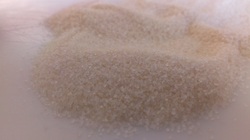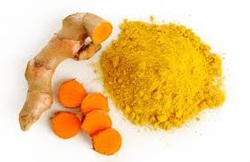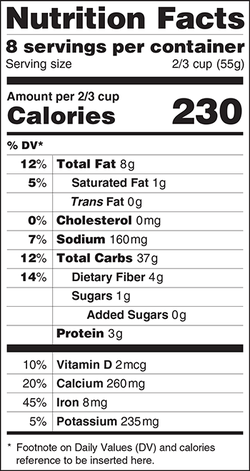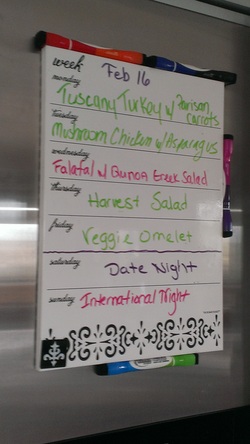|
As a dietitian, I am asked almost daily about probiotics these days since the gut microbiome and gut-brain axis are hot topics this year. Pre and probiotics play an important role, but there is still a lot more to learn. We know that eating a diet rich in fruits and vegetables, with some fermented foods ensures optimal gut health (no surprises there), but what we do not know is the effect of over supplementation on healthy individuals. Probiotics have been studied in various conditions and diseases and have shown positive outcomes as therapeutic interventions for some, but it remains strain and dose specific. Because of the high interest and mass marketing of probiotics, I have been working on a webinar about what the current research states about probioic use and which products can be beneficial (more to come on this later.) For know, here is what to look for when selecting a probiotic.
11 Comments
It has been awhile since I have posted, and over these past few years, a lot has happened in my life. I have struggled with infertility, had a child, lost a parent, moved to Oregon, and found new passions in my life. During this hiatus, I have also worked on my own personal development as a human being (emotional and physical.) It's amazing how having a child can motivate you to be your best in every aspect of life. All of this growth has changed my perspective and attitude, and has allowed me to experience new things in order to help others. In the upcoming months, I will be spotlighting a new topic that I have personally dealt with or are currently working on. I will be shedding light on these subjects with science and personal truths that will hopefully help you along your journey.
With that said, let's get started!  You may have heard about the new book by Eve Schaub called, “Year of No Sugar”. I have not had the opportunity to review this book yet, but have read several reviews about the content. This article is not intended to review this book, but to spark a challenge about how much “added” sugar is actually in your current diet. I am not focusing on certain types of sugars (i.e. fructose) that were omitted in Schaub book, but just any type of added sugar. So what is added sugar? “Added sugars are sugars and syrups that are added to foods or beverages when they are processed or prepared. This does not include naturally occurring sugars such as those in milk and fruits.”1 I feel I eat pretty healthy, and do indulge every so often, but I have noticed there are some unnecessary added sugars in my diet. Why should someone care about this? Added sugars are unnecessary empty calories that are typically stored as fat. They have also been linked to increased cardiovascular disease risk, weight gain, obesity, and can increase risk of diabetes. Sugar can also affect our mood and can cause act as an addiction as injection of it can trigger the release of chemicals such as serotonin, opioids and dopamine. Over time, people can develop a tolerance for sugar, meaning they need more sugar for a feel-good "fix”. This can cause a downward spiral in our overall health. I could go on as the reasons to limit added sugar are plentifully, but for the sake of time, let’s get started! I am taking a 30 day no added sugar challenge and I challenge you the reader, to do the same. To help you along the way, I am including a list of items and ingredients to look for to avoid added sugar in your challenge. Typical products you want to be wary of are:
Just cutting out added sugars is a challenge in itself, but if you want to make it a super-challenge, try cutting out all artificial sweeteners as well!! Your health and sweet tooth may thank you! References 1http://www.choosemyplate.gov/weight-management-calories/calories/added-sugars.html http://health.clevelandclinic.org/2014/04/added-sugar-added-risk-for-your-heart/ http://www.prevention.com/food/healthy-eating-tips/weird-effects-sugars-having-your-body  Turmeric goes by many names but it is commonly called Curcuma longa (domesticated) or Cucuma aromatic (in the wild). It is a relative of ginger, and is a perennial that grows in the tropical regions of Southern Asia. Its roots are bulbs that produce rhizomes (underground plant stems). Although it grows in many tropical locations, the majority of turmeric is grown in India and is used as a main ingredient in curry. It is also used as a medicinal herb in Ayurvedic and traditional Chinese medicine. Turmeric contains protein (6.3%), fat (5.1%), minerals (3.5%, carbohydrate (69.4%), and moisture (13.1%). The spice Turmeric has a warm, bitter taste, and is frequently used to flavor and color curry powders, mustards, butters, and cheeses. It is considered safe in cooking with minimal side effects. Alone or added to other spices, herbs, and aromatics, turmeric can boost the flavor of many dishes such as rice, chicken, turkey, vegetables or even salad dressing. It's also commonly used in pickling recipes to provide a zingy, tangy taste as well. Turmeric is best absorbed when combined with black pepper. Medicinal Purposes There has been a lot research done on the therapeutic advantages of turmeric and curcumin; almost too numerous to list. An overview published in Advanced Experimental Medical Biology in 2007 states that, "Curcumin has been shown to exhibit antioxidant, anti-inflammatory, antiviral, antibacterial, antifungal, and anticancer activities and thus has a potential against various malignant diseases, diabetes, allergies, arthritis, Alzheimer's disease and other chronic illnesses." This article will highlight a few of the more researched areas. Turmeric has been used for 4,000 years to treat a variety of conditions. In both Ayurvedic and Chinese medicine, it is used as an anti-inflammatory agent to treat digestive and liver problems, skin diseases, and wounds. Curcumin, the phytochemical found in turmeric, has been studied as a powerful antioxidant and has anti-inflammatory properties. It is the most active constituent of turmeric with very few side-effects and is generally considered safe; however, some people can experience stomach upset, nausea, dizziness, or diarrhea. Neither curcumin nor turmeric taken orally is well absorbed unless taken with black pepper or piperine, a constituent of black pepper responsible for its pungency. Curcumin has been shown in animal studies to stimulate the gallbladder to produce bile acids, which some people think may help improve digestion. One double-blinded, placebo-controlled study found that turmeric reduced symptoms of bloating and gas in people suffering from indigestion. On the other hand, turmeric does not seem to help treat stomach ulcers. In fact, there is some evidence that it may increase stomach acid, making existing ulcers worse. Studies of turmeric and curcumin have also shown to work as a non-steroidal anti-inflammatory drug for treatment of osteoarthritis; act as a weak phytoestrogen with some cancer protective effects; induces programmed death of colon cancer cells; and suppresses microinflammation in the GI tract associated with inflammatory bowel disease. The bottom line Turmeric and curcumin may have some exciting health properties, but there are not enough definitive human studies to make any recommendations at this time. Most of the research I have reviewed involved the extract curcumin. Until there is an extensive amount of data that the supplement is best, cooking with turmeric may be the best way to go. Whole foods are generally better and safer for the body. This article only suggests using turmeric as a spice in cooking. If you wish to take turmeric or curcumin as a supplement, please speak with your medical provider before doing so, as it can interfere with other drugs you may be taking and may not be safe for use for people who are undergoing chemotherapy, pregnancy, have GERD, or have gallstones. Turmeric may also slow blood clotting and taking turmeric along with anti-clotting medications might increase the chances of bruising and bleeding. Recipe Bobby Flay’s Oven Roasted Cauliflower with Turmeric and Ginger Courtesy of the food network.com (http://www.foodnetwork.com/recipes/bobby-flay/oven-roasted-cauliflower-with-turmeric-and-ginger-recipe.html?oc=linkback) Ingredients 3 tablespoons vegetable oil 1 tablespoon black mustard seeds 1 jalapeno, finely diced 1 tablespoon grated fresh ginger 1 teaspoon turmeric 1 head cauliflower, cut into florets Salt Directions Preheat oven to 425 degrees F. Whisk together the oil, mustard seeds, jalapeno, ginger, and turmeric in a small bowl. Place cauliflower in a medium baking dish and toss with the flavored oil and season with salt. Roast until lightly golden brown and just tender, 20 to 25 minutes. Serve hot. References
http://www.webmd.com/vitamins-supplements/ingredientmono-662-TURMERIC.aspx?activeIngredientId=662&activeIngredientName=TURMERIC http://www.3fatchicks.com/4-easy-ways-to-cook-with-turmeric/ http://www.drweil.com/drw/u/QAA400915/Curcumin-or-Turmeric.html http://www.huffingtonpost.com/andrew-weil-md/turmeric-health-have-a-happy-new-year_b_798328.html Chattopadhyay I. Biswas K, et al. Turmeric and curcumin: Biological actions and medicinal applications. Current Science. 87 (1): 44-53, 2004 Liu J Chen S, et al. Recent progress in studying curcumin and its nano-preperations for cancer therapy. Current Pharmaceutical Design. 19 (11): 1974-93, 2013 Asher GN Speiman K. Clinical utility of curcumin extract. Altern Ther Health Med. 19(2):20-2, 2013. Asher GN Speiman K. Clinical utility of curcumin extract. Altern Ther Health Med. 19(2):20-2, 2013.  By now you may have heard about the proposed new food label proposed by the FDA but are you aware how this may impact you? The FDA, in an attempt to align with the current scientific literature and nutritional recommendations, is updating the food labels. The following is the proposed label and the significant changes. The serving sizes are more in line with typical serving sizes one would eat and the total serving per container is accentuated. The “Calories” per serving print is very large and stands out and may be dramatically changed due to the new serving size guidelines proposed. First some background. The FDA set the current reference values (Reference Amounts Customarily Consumed, or RACCs), in 1994, which were based on Nationwide Food Consumption Surveys. More recent food consumption data show about 17% of the current RACCs should be changed for different food categories. In addition, the FDA is also proposing to add 25 new RACCS. The FDA is also proposing to require that some food products previously labeled as more than one serving be labeled as a single serving, because people typically eat or drink them in one sitting. Food packages containing between 150% and 200% of the RACCs could no longer be labeled as more than one serving. Certain larger packages that could be consumed in one sitting or in multiple sittings would be required to be labeled per serving and per package. This dual column labeling would be required if a package contained at least 200% of the RACC and less than or equal to 400% of the RACC. Packages containing more than 400% of the RACC, dual column labeling would not be required.2 Some other evident changes are the switch up of the %DV and the total grams will be on opposite sides to allow the consumer make better choices based on their overall daily intake. Other less evident changes is the requirement of “added sugars” on the label. Having this added to the product will immediately let you know if the sugars contained in the product are naturally occurring or added which makes a big difference in the overall nutritional benefit of the food item. Potassium and vitamin D will also be required on food labels which are important for chronic disease management. Vitamins A and C would no longer be required on the label. The Daily Values for sodium, dietary fiber and Vitamin D were reevaluated to current recommendations for overall health. “Total Fat,” “Saturated Fat,” and “Trans Fat” remain the same as the current label, the “Calories from Fat” would be removed to reflect current research which shows the type of fat is more important than the amount. The changes proposed will affect all packaged foods with the exception of certain meat, poultry and processed egg products, which are regulated by the U.S. Department of Agriculture’s Food Safety and Inspection Service. So, with that all said, how will it change the way you shop? The changes in the serving size are pretty important. I don’t know how many times I have picked up an item and wondered if people actually adhere to the serving size on the package. It is definitely misleading and causes confusion for some. It will also make product comparisons a little easier. For instance, most soft drinks will be considered a serving size instead of 1 ½ --2 servings as they currently are making it easily for the consumer to see how many non-nutritive calories there really are consuming in the product without having to do math. The one change I am most excited about is the “added sugar” line addition, as I feel it will be a very helpful feature. I’d have to say that most people are not aware of the amount of added sugar in products and I think it will be an eye opening fact for most. Will it change the way you purchase items? I hope, but at least it will make the consumer more aware. This week’s recipe is taken from Health-bent http://www.health-bent.com/sides/paleo-pad-thai Low Carb Pad Thai Ingredients
If you have a mandolin, slicing the zucchinis lengthwise. If you don’t have one you can use a knife to slice the zucchini as thinly as you can (lengthwise). Slice the slices into thin strips, just like the shape of a spaghetti noodle. Over medium heat, melt your fat of choice. Saute the onion, garlic and ginger, until soft. Add the fish sauce, chili sauce, vinegar, lime juice, almond butter and a bit of salt. Stir to combine. Add the zucchini noodles to the sauté pan. Stir them around to get the sauce incorporated onto the “zoodles”. The point here is get the "zoodles" hot and very slightly cooked through (just like an al dente noodle!), about 10 minutes. Serve hot. Any kind of grilled or pan seared meat or seafood would go really well with this. ------------------------------------------------------------------------------------------------------------------------------------------------ References: http://www.fda.gov/NewsEvents/Newsroom/PressAnnouncements/ucm387418.htm 2http://www.fda.gov/Food/GuidanceRegulation/GuidanceDocumentsRegulatoryInformation/LabelingNutrition/ucm387533.htm  Are you starting to get stuck? Some of the best intentions can be met with challenges. We lead such busy lives that it is hard to find “time” to do the things we should be doing. I cannot tell you how many times a day I hear, “I’d love to do that, but I just don’t have the time.” Well I hate to burst the bubble here but time is relative. All we need to do is create time! I know this may sound easier than it is, but it really is that easy! As soon as you say those words, “I don’t have time”, you already set yourself up for failure. Try to change your thoughts and words and say, “I will make time”. You will be surprised at what you can fit in when you change the way you think. With that said here are some tips to “save-time” and therefore allow you to stick to your plan. - Make a Menu Board. I don’t know how many times this has happened to me. I get home from work and had good intention to make something fabulous for dinner, but get home and just make something quick and easy, but not necessarily healthy. I am not saying quick and easy cannot be healthy, but a lot of times unhealthy food can be easy to just through in or pick-up. - To go along with the menu board, you will need to plan your meals in advance. This will also help with your shopping trip and will discourage you from buying those unhealthy impulse items that somehow end up in our carts. We sit down every Sat morning and go through the refrigerator and plan meals for the upcoming week, make a list, then hot Trader Joe's and Sprouts (we are very lucky to have these awesome stores!!) - Prep your lunch the night before. This way you can take your time to make a nice healthy lunch. You can also do this with breakfast (depending on what you have in the morning, I have a protein shake so it works great for me! - Make a work-out schedule. Sometimes when we are forced to write things down, it makes us a little more accountable. There are also some great apps out there that will get you motivated. http://www.pcmag.com/slideshow/story/292474/the-25-best-fitness-apps - Set out your work-out gear the night before. This way it is ready to go for you in the morning, Hope this helps! Recipe of the Week
Mushroom Chicken with Asparagus Ingredients: 2 Chicken breasts Salt (to taste) Pepper (to taste) 1 tbs Olive Oil / Avocado Oil 1 bunch Asparagus (washed and cut) 1/2 cup Feta Cheese Mushroom Basil Sauce (courtesy of allrecipies.com) http://allrecipes.com/recipe/basil-cream-sauce/ Directions: Preheat oven to 350 degrees. Use a meat mallet and pound out the chicken breasts so they are about ½ inch thick. Boil water and place asparagus in water until blanched. Dry and set aside. Place asparagus on chicken with feta cheese (divide between the 2 breasts), wrap and set aside. Heat olive oil in saucepan over medium heat. Place chicken breast in skillet and brown on both sides. Place in baking dish and drizzle with olive or avocado oil. Finish in the oven for ~30min or until 165 degrees. Make Basil sauce and pour over chicken. Valentine’s Day
What a wonderful day set aside once a year to focus on the loved ones in your life. This doesn’t me it is an excuse to go off your meal plan! You can still have a great valentine’s day without indulging in candies and sugary goodies. Here are some ideas to start you out with. Have an exercise date! New fun fitness trends are always popping up. Take to the sky at a trampoline park; try rock climbing; take an aerial or trapeze class; or go roller / ice skating together. Whatever you may decide to do on this day, remember to make it ACTIVE! If food is on your mind, and you are watching your carbs, steak and/or lobster are a great option for the main course. Just pair it with a nice salad or (my favorite) Brussels sprouts. Dessert can be a little tricky. It is pretty hard to find a low-carb dessert without a lot of artificial sweeteners or sugar alcohols. A few lower carb options are: Peaches and Cream - (1 cup peaches and fresh whipped cream), you can also use 1 cup chopped strawberries or ½ cup blueberries. - For the whipped cream - 1 cup heavy cream - 1 Tbsp. Stevia (optional) - 1 tsp vanilla extract (optional) Whip heavy cream with an egg better (I just use my ninja) until stiff. If you are adding vanilla or sweetener, add it in before it stiffens Cheesecake Cupcakes: http://www.nuttyabouthealth.com/2013/01/13/low-carb-cheesecake-cupcakes/ Dark Chocolate Covered Strawberries – use higher cacao chocolate (lower carbs) a good one I have used before is Ghirardelli Midnight Reverie 86% Cacao. Making these is so simple. Melt the chocolate in a double broiler and dip in washed strawberries. Today we are talking about carbs. Starches in particular. There has been a lot of talk lately about starches and grains being “bad” for you. I recently went to a lecture from the NY Times bestselling author of Grain Brain, Dr. David Perlmutter. Now, the evidence is overwhelming (and has been) regarding lower carbs diet and cardiovascular and neurological health, but Dr. Perlmutter is also claiming that gluten is to blame for the rise in dementia, decreased libido, depression, chronic headaches, anxiety, epilepsy, and ADHD. If you are interested in reading a great article about this topic please see http://www.theatlantic.com/health/archive/2013/12/this-is-your-brain-on-gluten/282550/.
Since the jury is still out on gluten, I am going to focus on good grains this week to incorporate into your diet. One of my favorites is quinoa! It is a great grain (actually a seed) packed with fiber and protein (provides all 9 essential amino acids). Others grain to include in your meal plan are whole grains (make sure it says this in the first 2 ingredients. Examples of whole grains include: · Barley · Brown rice · Buckwheat · Bulgur (cracked wheat) · Millet · Oatmeal · Whole-wheat bread, pasta or crackers · Wild rice Adding any of these into your diet is a great healthy decision. If you are looking for something different to make this evening, check out these great recipes for quinoa from cooking light!! http://www.cookinglight.com/food/recipe-finder/cooking-with-quinoa-00412000073996/ It’s super bowl time!! Whether it will be on Friday, Saturday, or Sunday this year is still to be determined, but this will not change the fact that there will be snacks! Making healthy choices on this day is pretty hard, but not impossible. Keep up the good work you are doing by brining or preparing some alternates to the traditional Super Bowl snacks.
Here are some low-carb snacks ideas (for those of you trying to reduce your carb intake) for the big game: Plain or Roasted Nuts Cheese and sliced apples Mozzarella sticks* Chili (limit beans) Coconut Shrimp* Kale Chips* and Guacamole Chicken Kabobs* Crudité Platter with Hummus or Cucumber Dill Veggie Dip (make sure low carb) Carrots / Celery / Apples and Nut Butter Turkey Rolls with Cheese and Veggies* *Recipes ________________________________________________________________________ Turkey Rolls with Cheese and Veggies Turkey lunch meat Cheese (Goat or cream cheese) Cucumber Slice skin off of the cucumber and slice lengthwise. Spread cheese on turkey slices. Put cucumber on top of cheese. Roll the turkey. Some variations: add sliced red bell peppers; use flavored cheese (goat or cream) Chicken strips Chicken Breast or tenders Eggs Coconut or Almond Flour Marinade (see recipe) Slice chicken into strips (if using breasts). Marinade for a few hours. Take chicken and dip in egg and roll in almond or coconut flour (your choice for your flavor). Pan Fry chicken in olive or avocado oil browning on each side. Bake at 350 degrees for 30 min. Variations: Add basil and oregano to almond flower Basil-Marinade http://www.foodnetwork.com/recipes/grilled-basil-marinated-chicken-recipe0.print.html Total Time: 3 hr 31 min Ingredients 1 tablespoon olive oil 1 tablespoon red wine vinegar 1 tablespoon chopped basil leaves, plus 4 sprigs for garnish 1 tablespoon finely chopped red onion 2 teaspoons kosher salt 1 teaspoon whole black peppercorns 1 clove garlic, chopped Directions Whisk together the oil, vinegar, basil, onion, salt, peppercorns, and garlic in a bowl. Transfer the marinade to a gallon-sized sealable plastic bag with the chicken and shake to combine. Refrigerate for at least 3 hours and up to 12 hours. Coconut Scrimp http://lowcarbdiets.about.com/od/fishandseafood/r/Coconut-Shrimp.htm Yield: 3 Servings Ingredients:
1. Mix coconut flour with red and black peppers, and salt. 2. Whisk the eggs with a fork in a small dish, and mix with the 2 tbs water. Add sweetener if desired. 3. Put shredded coconut in a separate dish. 4. Put oil in a large skillet to about 3/4 inch depth. Heat to 350 to 360 degrees, or until the end of a wooden spoon handle dipped into the oil collects bubbles around it. 5. Holding shrimp by the tail, roll in coconut flour, and shake to get most of it off - you just want a thin coating. Then dip in egg, again shaking off the excess. Finally, roll in coconut. 6. Fry the shrimp until golden on each side, about 2 minutes per side. I usually put each in the pan as I prepare them, but you have to watch the ones in the pan closely if you do it this way. An alternative is to bread a few at once and then put them all in the pan at the same time. Don't crowd the pan, which will lower the temperature of the oil - this makes them absorb more oil and end up heavy and greasy. Tongs are the best tool for turning and removing the shrimp. 7. Remove from the pan to a paper towel or cooling rack. Note: It's probably not possible to get exact nutritional Spinach Artichoke Portabella Quiches http://alldayidreamaboutfood.com/2013/12/spinach-artichoke-portabella-quiches-low-carb-and-gluten-free.html#SP63lFL3jlpy5Yru.99 Yield: 6 quiches Serving Size: 1 quiche Ingredients
Artichoke Dip (if you want to make your own) Ingredients 1 cup chopped artichoke hearts (canned or frozen and thawed) ½ cup frozen chopped spinach, thawed 8 oz cream cheese ½ cup grated Parmesan cheese ½ teaspoon crushed red pepper flakes ¼ teaspoon salt ⅛ teaspoon garlic powder dash black pepper Directions
Mozzarella sticks Ingredients Mozzarella sticks (1bag) Almond flour Eggs Avocado Oil or Vegetable Oil Take mozzarella cheese sticks and cut in half, dip in egg and roll in almond flour. Fry in avocado oil or vegetable oil in skillet. Serve immediately Kale chips Ingredients: kale leaves olive oil sea salt Directions: Wash and dry kale leaves and tear into bite size pieces. Grease a large baking sheet and spread the kale evenly across it. Drizzle about 2 tbsp olive oil across the kale pieces and topped with sea salt. Bake at 350 degrees for 15 minutes. The kale shrinks up so more is less. Ireland, it was only a 10 day adventure for us, but what an experience! I will not be able to share my experience in one blog, so it will be broken up into several installations. Ireland is such a lush and beautiful country with so much of it still left untouched, including the food! Food is still made very similar to the way it was many years ago, real, fresh, and with unprocessed ingredients. Recipes are still handed down throughout generations. Ireland does have its share of processed foods, but not as much as in the states. For example, as we were driving around Ireland we saw a lot of livestock, and not one of them was in a small muddy pen. These wonderful animals were left to roam in some of the most beautiful terrain I have seen so far in my travels. ALL of their beef is grass-fed and free range! This is true for their lamb as well (another Irish specialty). I even noticed a difference in the milk. It tasted a little creamier. Beef is an important mainstay in their diet and has been for many centuries, as cattle played an important part in Irish food from the middle ages until the arrival of the potato in Ireland in the 16th century. The meat was predominantly food for the rich with the poor making do with the milk, cheese and butter which were supplemented with grains and barley for nourishment.  Oh, and speaking of butter. It was the most decadent and delicious butter I have ever tasted!! I can see why the Irish use a lot of butter in their diet. In a scholarly article from 1960, A.T. Lucas wrote that “recent international statistics show that the consumption of butter per head of the population is higher in Ireland than almost anywhere else in the world.” The Irish like their butter plain and flavored. From the 12th century on, there are records of butter that was flavored with onion and garlic. Despite hearing the warnings from a few that have traveled before, the Irish gastronomy was quite tasty. Yes, they make a lot of dishes involving potatoes, but what they can do with a potato is amazing! The Irish diet is heavy on dairy, meat, cabbages, onions, garlic, and parsnips, with some wild herbs and greens, and potatoes. As far as fruit goes, they eat wild berries, like blackberries and rowanberries, and apples. If you lived near the coast, edible seaweed like dulse and sloke made for tasty salads and side dishes. Being that most of the Irish dishes are heavy with a lot of red meat and heavy dairy (creams, cheese, and butter), it is not too surprising that cardiovascular disease (CVD) is the #1 cause of death in all of Ireland. I definitely noticed as the first thing I wanted when I came back to the states was a HUGH salad! The closest thing I had that came close to a salad while I was in Ireland was some red rocket (arugula / salad in Ireland) with tomatoes, but that is for another discussion. In this installment, I will discuss breakfast which is as we all know, (say it together kids), “the most important meal of the day”. The traditional Irish breakfast, while be it yummy, is a bit of a heart-attack on a plate if eaten daily. I was assured by the locals that it is not and typically eaten once or twice a year… or daily for a tourist on holiday;) The traditional breakfast consists of bacon/ham, poached or over easy egg, sausage, beans, potatoes, roasted tomato half, and black (blood) and white pudding. The puddings are not for everyone. I must say that I can be quite adventuresome, but I just could not try the pudding. It actually is not a pudding but a sausage made from pigs' blood, onions, herbs, spices, oatmeal or barley. It is then sliced and fried and served for breakfast. If you are interested in trying this as St. Patrick’s day meal, the following are the traditional directions for preparing this dish (courtesy of http://www.foodireland.com/recipes/Breakfast/irishbreakfast.htm): Place a knob of Irish Butter on a frying pan or skillet. (There is a noticeable difference in taste when you use Irish Butter over cooking oil ) Over a medium heat, fry the bacon until it’s done the way you like. Try not to cook it like American bacon which is usually done until real crispy. Keep the Irish Bacon soft and well browned. With four plates in the warming section of your oven, place the cooked bacon on one plate and keep hot. You can place a paper towel on the plate to absorb excess fat from the bacon. Place the sausages on the frying pan and cook till golden brown all around. Place in oven on a second plate - keep hot. Empty contents of can of beans in to a small saucepan and place on low heat. Slice the puddings and place on the frying pan. Cut the tomatoes in to quarters and place on pan also. Slice the Previously boiled chilled potatoes in to slices about 1" thick and place on pan. Fry the tomatoes, puddings and potatoes till golden brown both sides. Place in the oven and keep hot. Finally, fry the eggs and grate Dubliner cheese on top if desired. This breakfast is great washed down with Irish tea and served with brown bread. Outside of the traditional breakfast, most Irish have a small breakfast consisting of a piece of toast and tea, or some fruit or oats, which were also a staple in the Irish diet. Oats not only fed the family but also supported the livestock. In fact, Ireland has now expanded and diversified its crops to include wheat, barley, and sugar beets, in addition to the favored potatoes and oats. |
Author
I love to share my knowledge about nutrition and wellness. Please feel free to contact me for topic requests. Archives
March 2020
Categories
All
|
Colene Stoernell MS, RDN, LD


 RSS Feed
RSS Feed
